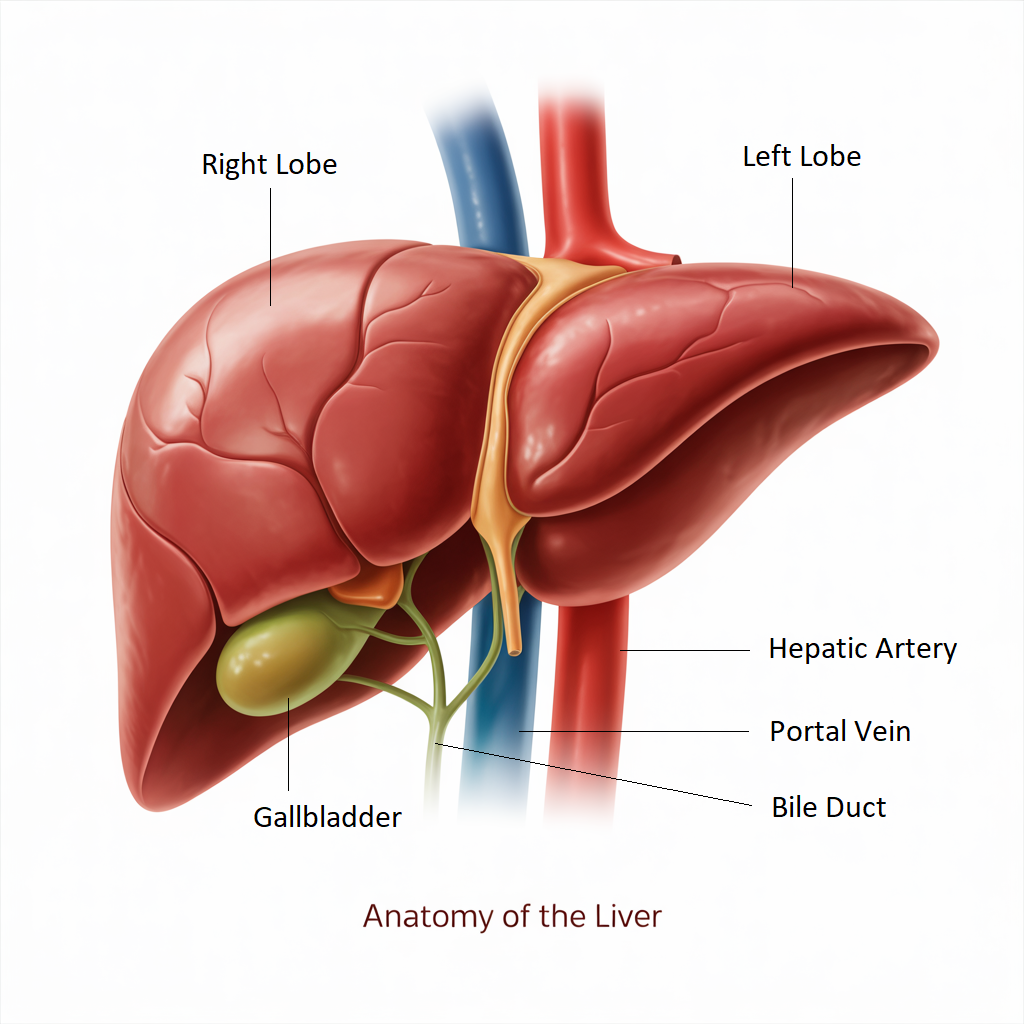The liver is the largest internal organ in the human body and one of the most vital for survival. Located in the upper right portion of the abdomen, just beneath the diaphragm, the liver performs hundreds of functions that keep the body healthy — including filtering toxins, aiding digestion, and storing energy.
What Is the Liver?

The liver is a reddish-brown, wedge-shaped organ that weighs about 1.4 to 1.6 kg (3 to 3.5 pounds) in adults. It is divided into two main lobes — the right and left — and is connected to the gallbladder, intestines, and pancreas through the bile ducts.
This powerhouse organ plays an essential role in metabolism, detoxification, immune defense, and digestion, making it critical to your overall health and well-being.
Main Functions
- Detoxifies blood: Removes harmful substances such as drugs, alcohol, and metabolic waste.
- Produces bile: Helps break down fats during digestion.
- Stores energy: Converts excess glucose into glycogen for later use.
- Regulates blood clotting: Produces proteins essential for coagulation.
- Metabolizes nutrients: Processes carbohydrates, proteins, and fats.
- Supports immune system: Acts as a barrier and filter for pathogens entering through the gut.
Anatomy Overview
| Part | Location/Feature | Function |
|---|---|---|
| Right Lobe | Larger, right side of liver | Handles most metabolic and detox processes |
| Left Lobe | Smaller, left portion | Shares essential functions with right lobe |
| Gallbladder | Beneath the liver | Stores and releases bile |
| Hepatic Artery | Supplies oxygenated blood | Delivers oxygen to liver tissues |
| Portal Vein | Brings nutrient-rich blood | Delivers blood from intestines to the liver |
| Bile Ducts | Network of channels | Transports bile to the gallbladder and small intestine |
Common Issues of the Liver
Liver problems can be silent for years but can progress into serious diseases if not caught early. Common liver conditions include:
- Fatty liver disease (NAFLD)
- Hepatitis (A, B, C)
- Cirrhosis
- Liver cancer
- Hemochromatosis (iron overload)
- Wilson’s disease (copper accumulation)
- Gallstones (related to bile flow)
Warning Signs to Watch For:
- Yellowing of the skin or eyes (jaundice)
- Abdominal pain or swelling (especially upper right side)
- Chronic fatigue
- Unexplained weight loss
- Dark urine or pale stool
- Itchy skin
- Nausea or vomiting
Best Practices for a Healthy Liver
Protecting your liver involves both lifestyle choices and regular health screenings:
- Limit alcohol: Excessive intake is a major cause of liver disease.
- Eat a balanced diet: Focus on vegetables, fruits, lean protein, and whole grains.
- Maintain a healthy weight: Reduces risk of non-alcoholic fatty liver disease.
- Stay hydrated: Helps flush out toxins efficiently.
- Exercise regularly: Promotes metabolism and reduces fat buildup in the liver.
- Avoid unnecessary medications or supplements: Some can be toxic to the liver.
- Get vaccinated: Against hepatitis A and hepatitis B if you’re at risk.
- Practice safe hygiene and avoid contaminated needles: Prevents viral hepatitis.
When Should You Consult a Doctor?
See a healthcare provider promptly if you experience:
- Persistent jaundice or abdominal pain
- Swelling in the legs or abdomen
- Chronic fatigue or loss of appetite
- Abnormal liver enzyme levels in blood tests
- Any signs of hepatitis or family history of liver disease
Early diagnosis of liver problems can greatly improve treatment outcomes.
Conclusion
The liver is essential to digestion, detoxification, metabolism, and more. With the right care, you can maintain liver health for life. At DNA Labs India, we offer advanced liver health screenings and genetic testing to help identify your risks early and guide your personalized wellness plan.
Contact DNA Labs India today to schedule your liver health assessment or learn more about our diagnostic services.
Frequently Asked Questions (FAQs)
Q1: What does the liver do in the human body?
A: The liver performs over 500 essential functions, including detoxifying harmful substances, producing bile for digestion, regulating blood sugar, storing energy, and helping with blood clotting.
Q2: Can the liver heal or regenerate itself?
A: Yes. The liver is the only organ in the human body capable of regenerating itself. With proper care, it can regrow even after significant damage — although severe, long-term injury like cirrhosis may become irreversible.
Q3: What are the early signs of liver damage?
A: Early symptoms may include fatigue, loss of appetite, nausea, and mild abdominal discomfort. As damage progresses, signs like jaundice, dark urine, and swelling may appear.
Q4: What causes fatty liver disease?
A: Fatty liver disease can be caused by obesity, insulin resistance, excessive alcohol consumption, or high cholesterol. There are two main types: alcoholic fatty liver disease (AFLD) and non-alcoholic fatty liver disease (NAFLD).
Q5: Is liver disease always caused by alcohol?
A: No. While alcohol abuse is a common cause, liver disease can also result from viral infections (hepatitis), genetic conditions, autoimmune diseases, or poor metabolic health.
Q6: How can I improve my liver health naturally?
A: Eat a balanced diet, limit alcohol, maintain a healthy weight, exercise regularly, avoid unnecessary medications or toxins, and stay hydrated.
Q7: Can you live without a liver?
A: No. The liver is essential for survival. However, people can live with a portion of a liver (such as after donation or surgery), thanks to its ability to regenerate.
Q8: How is liver function tested?
A: Liver function tests (LFTs) are blood tests that measure enzyme and protein levels to evaluate how well your liver is working. Imaging tests and biopsies may also be used when needed.


